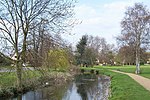The Riddy

The Riddy is an 8.4 hectare flood meadow and Local Nature Reserve located in Sandy, Bedfordshire, United Kingdom, bordering the River Ivel. Owned by Sandy Town Council but managed by both the Wildlife Trust for Bedfordshire, Cambridgeshire and Northamptonshire and Bedfordshire Rural Communities Charity, the 7.7 hectares (19 acres) site gains its name from a small stream which flows through the eastern end of the reserve. The different habitats in the Riddy support a diverse range of species, including a multiplicity of grasses and flowering plants in the meadows, aquatic plants and water voles which inhabit the ditches, ponds and stream, and birds which feed and hunt across the reserve.The Riddy is currently open to the general public; although some of the paths are reasonably rough, the site is most accessible via the riverside path: a disabled access gate is provided as well. The River Ivel may be fished from the reserve border, but a permit from the town council and national rod licence are required.
Excerpt from the Wikipedia article The Riddy (License: CC BY-SA 3.0, Authors, Images).The Riddy
Great North Road,
Geographical coordinates (GPS) Address Nearby Places Show on map
Geographical coordinates (GPS)
| Latitude | Longitude |
|---|---|
| N 52.1247 ° | E -0.296 ° |
Address
The Riddy
Great North Road
SG19 1GE
England, United Kingdom
Open on Google Maps






